Good Morning Diego Garcia has been named a Finalist in the E-BOOK NON-FICTION category of the 2016 Next Generation Indie Book Awards.
I’m delighted!

Inspiration and encouragement for your own personal journey of awakening …
Good Morning Diego Garcia has been named a Finalist in the E-BOOK NON-FICTION category of the 2016 Next Generation Indie Book Awards.
I’m delighted!
I live with my husband Doug, three dogs and a cat, in a sleepy beach town in Uruguay. I’m often asked, “Why Uruguay?” And I answer with confidence, “Why not Uruguay.”
There are dozens of reasons I can state, but the bottom line is nature and peace of mind. I have lived in many other countries and in today’s troubled world, Uruguay is a peaceful place to call home with friendly people and a relaxed life style.
Geographically the second-smallest nation in South America after Suriname, Uruguay is 68,038 square miles and about the size of the state of Washington (66,544 square miles). Washington state has more than 7 million people—and families and corporations continue to move there. In contrast, Uruguay is home to only 3.3 million people, of whom 1.8 million live in its capital and largest city, Montevideo.
The population of Uruguay is of European origin–mostly Spanish and Italian. Other foreign nationalities have immigrated here and contributed to its mix of culture diversity.
And Uruguay’s beaches are beautiful—one of the best kept secrets in South America.
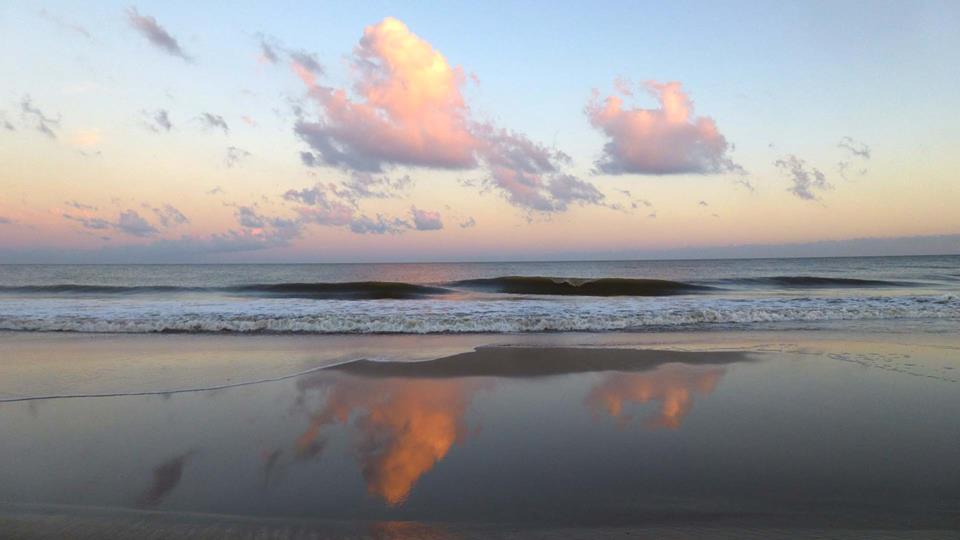
Here’s a photo of our dogs discovering a river dolphin on the beach near our home in Atlantida.
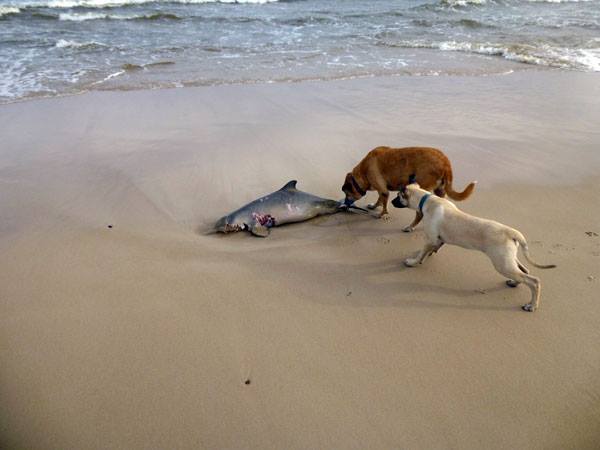
Our quiet beach town of Atlántida, Uruguay has a significant collection of quirky, cool buildings featuring a variety of innovative architectural designs.
One of the most famous structures was designed and engineered by Eladia Dieste, an architect who made his reputation by building numerous elegant structures from grain silos to churches. His buildings are a fusion of cutting-edge design and functionality featuring self-supporting double curved arches, built without any structural columns. We see this church often as it’s located near the butcher shop we frequent. It’s a must-see to share when we have visitors from abroad.
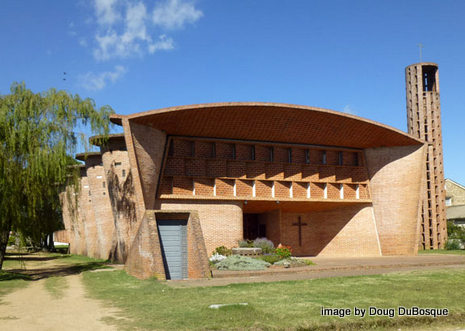
Iglesia del Cristo Obrero, designed by Elasio Dieste was built in 1958.
Another must-see favorite for originality is El Águila – The Eagle. In 1945, Italian millionaire Natalio Michelizzi, commissioned an Uruguayan builder (Juan Torres) to build him a statue of the Virgin Mary. Tores instead built a place where Michelizzi could read, paint and entertain. This meeting place for friends has given rise to several legends—from a Nazi observatory, a cosmic energy center, to a smuggler’s hideout.
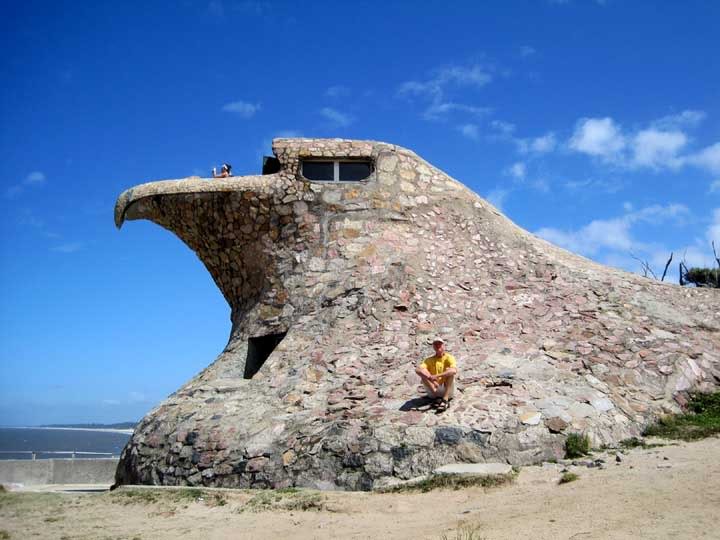
And we also find Uruguay to be the perfect base for exploring other countries in South America. We’re traveling to Peru in July to tour some ancient civilization sites. Anyone ever heard of the knotted string records??? They are some of the most tenacious mysteries of ancient Peru kept by the Incas.
Why Uruguay? Why not Uruguay.
“Diego Garcia!—August 1975
Time is but an illusion.—Einstein
Relieved to have finally crossed the equator after so many wild days at sea, I washed a bucket full of dirty clothes, hung them on a line to dry, and sat on deck reading while the fresh ocean breeze dried the laundry.
I spotted a bright orange ball starboard. “Look,” I said pointing it out to others. “Is it a buoy?”
“Looks like one,” Charles said.
“A buoy in the middle of the ocean?” I asked.
“Could be weather related,” Charles said. “Collecting data for reports.”
“Or marking a navigational hazard,” Alon added.
“Let’s find out,” Dylan said. The men moved to adjust the sails and steer the yacht in the direction of the big ball.”
“By the time we reached the buoy, the men decided they had to check it out. Alon lowered the sea anchor bags to keep the boat in place, and lowered the ladder into the water.
Charles and Alon put on swim fins and lowered themselves into the ocean. Donning masks, they swam around the buoy to see what they could see in the water below.
When they surfaced a few minutes later, Charles said, “Can’t tell what it is, it’s tied to something further down.”
They snorkeled around the bouncing buoy again, pulled on the attached rope, and tried pulling the object loose. It didn’t budge. They surfaced to report they had no clue what it was or why it was there.
“We would need scuba tanks to go further,” Charles said. “It’s tied tight to something quite heavy.”
“Look,” I said, pointing to a large ship appearing on the horizon. “We have visitors.”
“They’re speeding our way,” Dylan said, looking through his binoculars.
“Coming straight toward us,” I added.
Charles and Alon scrambled up the ladder and placed it and “the anchor bags back on deck.
“Looks like a military vessel,” Dylan reported. “They’ve appeared out of nowhere.”
“Uh-oh,” said Charles. “Wonder what’s down there?”
When the ship got closer, Dylan identified it as a Russian military ship. It did a broad sweep around the Zozo and without delay sped away, heading east, and disappearing from view.
“Spooky,” I said to Charles. “Don’t think they’re collecting weather data. They must have been alerted when you pulled on the rope.”
Charles nodded.
11 Memoir Authors Today April 5
Eleven best-selling memoir authors will be joining Sezoni Whitfield for an evening of awe…some! You’ll meet Savannah Grace, Susan Joyce, Tony James Slater, Sarah Jane Butfield, Frank Kusy, Joe Cawley, Beth Haslam, Shawn Inmon, Alan Parks, George Mahood, and Victoria Twead.
Check us out on twitter from 2:30pm EDT time! #MemoirMadness #WritersKaboodle
https://www.facebook.com/Sezoni
See you there!
MEMOIR MADNESS-ALL 99p/99c!!!!!
Some of our authors have got together to bring you #memoirmadness. All these WLM books are reduced this week to just 99p/99c, plus the authors of these memoirs will be taking part in interviews on twitter and Facebook. They will be on twitter at 7.30pm UK time today answering questions using the #memoirmadness and the Facebook event is on Tuesday evening. Click this link (the blue writing) to check out all the books on offer and all the links to buy are on there-just click the relevant book cover/s.
http://www.memoirmadness.moonfruit.com/
Then click the picture link for info about the memoir madness event.
https://www.facebook.com/events/1688712111400723/
Indian Ocean, July 1975
A Bit of Calm
You don’’t have a soul. You are a soul. You have a body.—C. S. Lewis
After what seemed an eternity, the winds had died to a whisper, and the threatening clouds had drifted away. The sea became flat and still. So still and smooth, it looked like a sheet of glass on a lake, but we were far away from any lakes. We were out in the middle of the Indian Ocean. I gazed at the peaceful blue sea and sky surrounding us, and walked around the deck at a slow pace, looking into the distance, as far as I could see.
Charles and Alon helped Dylan raise the sails. I heard Dylan complain about the difficulty of moving forward with a broken rudder and the loss of the mizzenmast. “Much harder to steer,” he grumbled.
I went back to our room to have a sea water shower while the weather was cooperating.
When I came back up, I saw Mia sitting alone at the table in the galley. Her eyes were tearing.
“Are you okay?” I asked.
She nodded and looked away.
I grabbed a cup of coffee and some dried fruit and nuts and returned to the deck.
Dylan reported he saw a ship on the horizon. I could see something faraway to the west. He went below and tried to reach them on the marine VHF radio, to ask if they could give us a weather report. He tried several times. No answer. He even tried contacting them with a signal mirror. No reaction. I saw his disappointment as they disappeared over the horizon.
I was fascinated with the signal mirror (a disk with a hole through it) and asked Charles about it.
“Standard,” Charles sort of explained. “A valuable communication tool. It reflects light from the sun to a nearby surface like your hand or a raft. Been in use since long before the VHF radio.”
“How does it work?” I asked.”
“You bring the mirror up to your eye and tilt it until you see a small bead of light. Next move the light toward your target. When your eye is in line with the target, you’ll see a bright spot. Pivot the mirror toward the object you want to signal. You can send signals by sending flashes of light. Doing this three times in quick succession is the international distress signal.”
“Oh!” I said. “Good to know.”
At last, Dylan was able to get an accurate read on our location. He told Charles we had gone south instead of southwest and we were heading in the direction of Diego Garcia.
“Diego Garcia? Is it a country?” I asked Charles.
Charles nodded.
So how was he finally able to get a precise reading?”
“During the storm we were pushed off course,” Charles explained. “The rough weather knocked the chronometer off the wall. Mia hung it back up, but forgot to tell Dylan.”
“Is it the time piece which hangs in their room?” I asked.
“Yes, he kept taking a fix on the chart based on the time showing on the chronometer. Unfortunately, it was not showing the right time.”
“How frustrating. How did he find the correct time?”
“Marine Radio. It’s amazing. Latitude can be found accurately using celestial navigation. Longitude, however, requires the exact time-of-day difference between the starting location and ending location. Without the precise information, the mathematical calculation can be off by 150 miles or more. Non-directional beacons from marine radio signals help obtain a fix of geographic location. A fix is computed by extending lines and reference points until they intersect.”
“Sounds complicated,” I said.
“It is,” Charles replied.
“Can Dylan get us back on course?”
“I’m certain he can navigate us to safety.”
“If he can, Sinbad is a good sailor,” I said, wishing it so.
The boat seemed to be sitting still; barely moving. But after so many stormy days, sunshine and a calm blue sea soothed my soul. I sat on deck and read for hours.
Indian Ocean, July 1975
“Dusk turned to night. Gentle swells rolled in from the west, indicating the sea’s unease. I went up on deck for some fresh air. The ship rolled port and starboard a few times, settling into a steep heel because of the strong winds. The full moon night with a complex mix of shadows and light, and the rolling motion, put me into a trance.
“Put on a safety harness.” Dylan yelled. “Click into the jack line.”
I followed his orders and moved closer to the deck’s edge. My eyes searched the deep swirling ocean. I saw screaming faces twirling about, crying out for help. Were they lost souls who had died at sea? Their distraught faces looked identical to the ’‘scream’ painting by Edvard Munch; the infinite scream of nature. I stared at them for quite a while.
They seemed to float in an alternative universe, a different dimension. How had I sensed their screams while no one else seemed to hear them? How did I move into their frequency? I kept staring at them. “How can I help you?” I asked.
My guardian angel whispered. ’‘Tell them to let go and move on.’
“Move on?” I asked. “To where?”
“‘Wherever their souls take them,’ she said.
A bright moon emerged through a break in the clouds. I blessed each soul with the moon’s reflected light and let them know it was okay to let go of limbo, and move on.
In the blink of an eye, the faces disappeared, the wind died, and the boat stabilized.
How could I see images no one else seemed to notice? Was it my imagination forming new images and sensations that are not normally perceived through normal senses such as sight and sound? Am I dead or alive? Perhaps I’m in purgatory awaiting word of release before going on to heaven. That’s ridiculous, I thought. I’m not even Catholic.
Charles was on deck, so I asked him if he had seen and heard the screaming faces.
“No,” he said. “But it’s a crazy time. In addition to feeling sick, I feel like I’m also going mad.”
“The Zozo moved on through deteriorating weather. I unhooked from the jack line and went inside to the galley. I grabbed my journal and made notes about seeing the lost souls, and sketched a drawing of a scream face.
Did the souls move on to another dimension?
Had they died at sea? Perhaps in a shipwreck?
The wind blew steadily for hours. We rocked and rolled on the steep seas. I heard Dylan say the winds were reaching gale force. He said it often as he went up and down the stairs, to refill his coffee cup and check the boat’s compass to verify direction.
“The compass is still the single most valuable navigational tool,” I heard him tell Charles. “Helps us know what direction we’re heading.”
“A good thing,” I heard Charles mumble.
Dylan was having a hard time trying to keep his coffee cup steady as he moved up and down the stairs. Coffee kept spilling over the edge of his cup.
He made notes in the ship’s log to measure distance sailed, and continued to tap the barometer several times a day. When he saw the pressure falling fast, we scurried to prepare for another storm.”

http://writerwonderland.weebly.com/goddess-fish-tour/good-morning-diego-garcia-review
A good adventure is one you survive. A great adventure occurs, when not only do you survive, but you learn something from it. Ms. Joyce survived not only one, but also two great adventures. While she details her adventures from a first person narrative, including many personal details, it also highlighted how little respect women were afforded even in the 1970’s. From Ms. Joyce not having control of her money to her husband making the decisions that involved both of them.
This enlightening memoir included growth and insight along with her travelogue touches. It also took me back to a time where traveling across the world was not an easy thing, and was often dangerous. Kudos to Ms. Joyce for being lucky in this lifetime and in all the others too.
Thank you! writerwonderland!
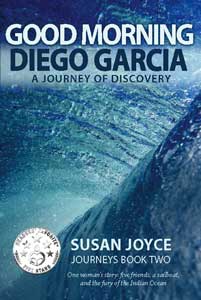
Indian Ocean, July 1975
I followed and tried to help. Squalls with sudden, violent gusts of wind could sink a boat. We were all acting fast to lower the sails and secure them with lines. Quick action was the only way to keep a boat under control during severe weather.
Sails lowered, we went back to the safety of the galley. Dylan closed the hatch to keep out the wind and rain.
“A sudden gust can topple any sailing ship,” Mia said.
“Why?” I asked.
“Because you can’t react fast enough to match the sudden change in force.” Charles explained. “You have to keep a close watch of changing skies, so you know before it arrives”
“A sea twister is like a tornado on land, right?”
“Yes, it is a whirling column of air and water mist. A funnel cloud,” Charles said. “And quite destructive.”
I could hear the ferocious wind blowing and see the swells rise higher. Two visible water spouts, about forty feet in the distance, were sucking water from the sea while lightning strikes lit up the dark sky.
“Glad we’re not out there,” I said, as the boat heaved back and forth in the raging sea.
When the worst of the dark clouds and strong winds had passed, Dylan opened the hatch and climbed up on deck to take his turn standing watch for other ships or obstacles in the area.
Not knowing where we were and with sails lowered, Dylan decided to continue letting the winds take us where they would until the storms cleared.
The men kept constant vigil during watch.
Charles mentioned the cross bar on the main mast kept plunging into the water, and jolting back to the other side as the ship rolled side to side with the mountainous waves. “Keeping watch is the only thing which keeps me from losing my mind,” he said.
“Not exactly pleasure yachting,” I said. I knew he was having a hard time dealing with this.
“Watching the ship’s course indicator, and other instruments keeps my mind occupied,” he replied. “Keeps me from going insane.”
“Opportunity of a life time is the way you described the adventure before we left sunny California.”
“What was I thinking?” he muttered, questioning his original thoughts of a fun high seas adventure.
“It will be opportune, when we survive.”
Charles trembled. He looked pale.
“Are you okay?” I asked.
“Weak from lack of food and sleep.”
“These squalls and waves are overwhelming.”
“It’s difficult to sleep knowing how easily a boat can tip over,” Charles added.
“Let’s hope Zozo’s hull is as great as Dylan claims.”
Charles nodded. “If it takes in water, it will sink. And it will happen fast.”
“A matter of seconds, minutes?” I asked.
“In an instant.” He snapped his fingers. “No time to grab a life jacket or launch a raft.”
We looked at each other and sighed.
Charles bowed his head.
“It is disheartening,” I said. “Hard to think clearly. But I think we’ll make it.”
“I hope you’re right.”
“The ultimate struggle for survival happens mentally,” I said.
Charles looked at me as if I were a stranger. “Have you had one of your crazy dreams?” he asked.
“Several,” I answered.
Squalls arrived frequently. Their strength varied. Some were severe with strong winds and heavy rain while others passed us by with little action or damage. The problem was not knowing how extreme they would be until they were directly overhead.
Huddled together in the galley the following morning, we sat silent again and listened to the angry sea.
Dylan decided it was too dangerous for anyone to be on deck. He closed the hatch and went to his stateroom.
Charles sat in a corner cleaning his fingernails with a penknife, clearly depressed. I had hoped to find alone time to ask him about Mia’s strange question. It would have to wait for calmer seas and clearer thinking.
Mia and Alon also seemed distraught. No wonder! We were all agitated, knowing the dangers we faced. The continual pounding wrought havoc on our frayed nerves.
“Eima, Eima,” I heard Mia call out several times, as if praying for her mother to save her.
“Heaven help us,” I cried out, hoping the skies would clear, and the storm would move on.
But the freak waves and hard winds continued to pound. Waves so steep, I felt like I was on a wild roller coaster ride which couldn’t stop. No brakes! No breaks. We were at the mercy of nature. No place to run. No place to hide. Hang on tight.